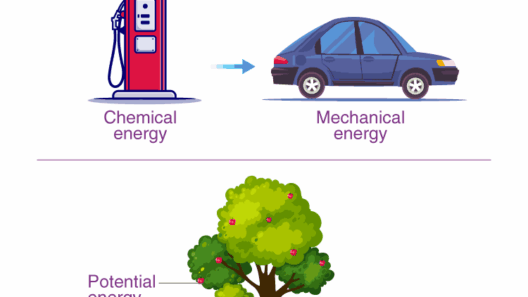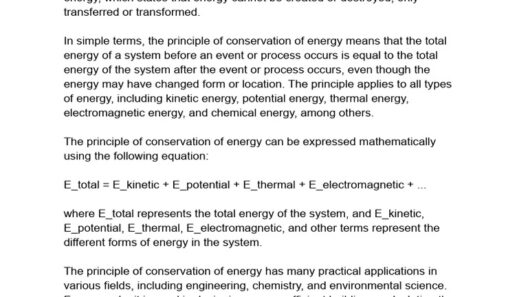Understanding intricate scientific principles is essential for comprehending the foundations upon which our universe operates. One such fundamental principle is the Law of Conservation of Energy. This law serves as a cornerstone in both theoretical and applied physics, influencing a wide array of fields from engineering to environmental science. Let’s explore this foundational law, its implications, and its everyday applications.
The Law of Conservation of Energy is a powerful assertion that energy cannot be created or destroyed; it can only transform from one form to another. This principle underscores the idea that the total energy within a closed system remains constant over time, despite undergoing continuous change in its form. From kinetic energy to potential energy, light, thermal energy, and beyond, the manifestations of energy are diverse and multifaceted.
To gain deeper insight into this law, it’s pivotal to explore various dimensions where it plays a significant role.
Energy: The Lifeblood of the Universe
Energy is a crucial element that sustains life on Earth. It is present in multiple forms, including mechanical, thermal, chemical, electric, and nuclear energy. The crux of the Law of Conservation of Energy rests in the capacity to convert one form into another. For instance, when a car accelerates, the chemical energy stored in fuel transforms into kinetic energy, allowing the vehicle to move. As the car comes to a stop, that kinetic energy is dissipated in the form of heat due to friction, further validating that while energy changes form, the total amount remains unaltered.
This transformative capability is not confined to mechanical systems; it extends to biological processes as well. In ecosystems, plants convert sunlight into chemical energy through photosynthesis. This energy is then transferred through the food web, from herbivores to carnivores, demonstrating that while energy may shift shape—ultimately, the sum remains in balance. The interdependence of species underscores the relevance of this law in understanding ecological dynamics.
The Implications of Energy Conservation in Physics
The Law of Conservation of Energy holds profound implications in various scientific domains, particularly in physics. It serves as a fundamental principle in mechanics, thermodynamics, and electromagnetic theory. For example, in the realm of thermodynamics, this law is intricately connected to the first law of thermodynamics. It posits that the total energy of an isolated system is conserved when considering heat transfer and work done within the system.
A common illustration can be found in the study of pendulums. As a pendulum swings, potential energy at its highest point transitions into kinetic energy at its lowest point. The interplay between these energy forms, while maintaining the overall energy balance, not only helps to elucidate mechanical behaviors but also provides insights into energy efficiency in real-world applications. Understanding these principles allows engineers and scientists to design systems that optimize energy use and reduce wasted energy, thereby enhancing sustainability efforts.
Applications in Modern Technology
The relevance of the Law of Conservation of Energy extends into the technologies that shape our daily lives. Renewable energy systems, like wind and solar power, represent significant advancements towards a sustainable future. In these systems, energy is converted from one form to another, effectively harnessing natural processes to generate electricity. For instance, solar panels convert sunlight into electrical energy, underscoring the continuous cycle of energy transformation.
Equally important is energy storage technology, crucial for balancing supply and demand. Batteries and capacitors store chemical or electrical energy, which can be released when needed. These technologies embody the principles of energy conservation, ensuring that energy generated at one time can be used later, contributing to the reliability of power systems.
Moreover, the conservation of energy finds applications in automotive engineering, particularly in electric and hybrid vehicles. These vehicles rely on energy efficiency to maximize the distance traveled per charge by converting electrical energy into kinetic energy, showcasing not only technological advancement but also a significant stride towards reducing the carbon footprint associated with traditional combustion engines.
The Societal Significance of Energy Conservation
As discussions surrounding climate change and environmental sustainability grow increasingly urgent, the Law of Conservation of Energy provides a foundation for understanding our energy challenges. By recognizing that energy must be managed rather than wasted, societies can adopt more sustainable practices. Initiatives promoting energy efficiency in homes—such as improved insulation, energy-efficient appliances, and smart technologies—are practical steps toward reducing the overall energy consumption while minimizing environmental impact.
Furthermore, the law encourages individuals and policymakers to invest in research and development of innovative energy solutions. Transitioning to renewable sources and improving energy systems is integral to mitigating climate change and fostering ecological balance. It necessitates a collective understanding of energy as a finite resource that must be safeguarded and optimized.
In conclusion, the Law of Conservation of Energy is more than merely a scientific principle; it is a guiding framework for sustainable practices in our daily lives and a crucial factor in addressing global energy challenges. Understanding this law reveals the intricate connections within ecosystems, technological advancements, and societal systems, emphasizing the importance of conserving energy for the well-being of our planet. Embracing the spirit of this fundamental law can lead to a more sustainable future.







